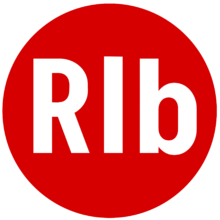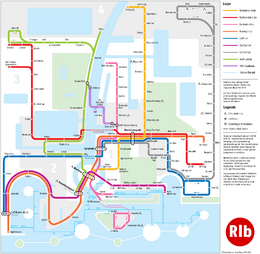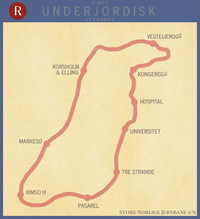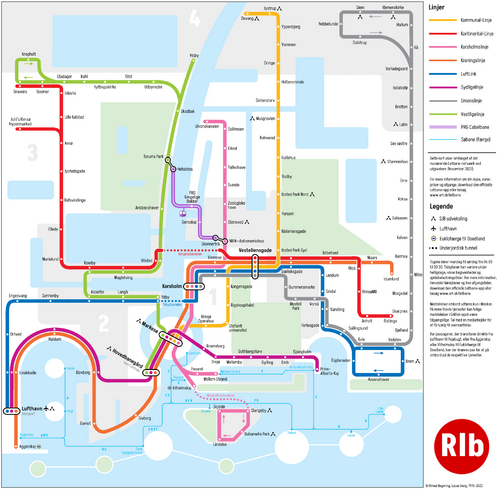Rimso Letbane
Template:KylarisRecognitionArticle
 | |||
 A Skredsvik 2101 of the Union line travelling at Karmoy | |||
| Overview | |||
|---|---|---|---|
| Native name | Rimsø Letbane (Mescon) | ||
| Owner | City of Rimso (50%) Government of Mesconia (50%) | ||
| Area served | Greater Rimso Oxvang Jystrup Klemenskirke Siem | ||
| Transit type | Rapid light rail | ||
| Number of lines | 8 | ||
| Number of stations | 122 | ||
| Annual ridership | 350.7 million | ||
| Headquarters | Rimso Letbane hoveddepot 114 Gælisksgade Rimso | ||
| Website | www | ||
| Operation | |||
| Began operation | 1975 | ||
| Operator(s) | Musse-Broskov Transportere Ltd. | ||
| Number of vehicles | 198 | ||
| Technical | |||
| System length | 138.6 km (86.1 mi) | ||
| Track gauge | 1,435 mm (4 ft 8+1⁄2 in) standard gauge) | ||
| Electrification | 750 V DC OHLE | ||
| |||
The Rimso Letbane (Mescon: Rimsø Letbane, "Rimso Light Rail"), commonly referred to as just the Letbane (/lɛt'beɪn/), is the primary rapid transit system for the city of Rimso, the capital of Scovern, also serving the neighbouring municipalities of Jystrup, Klemenskirke, Oxvang and Siem. The Letbane is the largest urban light rail network in Euclea by track length and annual ridership.
The Letbane first opened in 1975, serving the centre of Rimso and providing connections to the main station and the airport. Four lines (Western, Korsholm, Southern and Municipal) originally opened in 1975, with the network doubling its network with the Union line in 1980, the Continental line in 1987, the Coronation line in 1994 and LuftLink in 2000. Expansions to the network have been continual since its opening in 1975 and it has since become known as one of Euclea's most efficient rail networks.
History
Origins
Light rail in Rimso has its origins in horsecars in the late 19th century. Hennish engineers Hendricus Lier and David Hutterd designed and operated (under Hutterd & Lier a/s) the first horse-drawn trams in Rimso, which operated between Kongensgade and Vesteliensgade. These horsecars were electrified gradually between 1904 and 1912, and by 1920 horsecars had been phased out of urban transit in Rimso altogether.
Rimso Underground
In the early 20th century, the opening of several underground urban transit systems across Euclea led to similar proposals across the city of Rimso. One such proposal was the Rimso Underjordisk Jernbane, commissioned by Store Nordlige Jerbane a/s (Great Northern Railways), the primary rail company in Scovern at the time. The proposal consisted of a continuous loop, whereby trains would run clockwise (inner loop) and anti-clockwise (outer loop). It was the first such proposal seen in Euclea, and the company drilled many of the tunnels underneath Rimso to accommodate this network. The Underjordisk remained uncompleted, only partially laid down with rail, due to the company going bankrupt during the Great Collapse in 1916. The tunnels drilled for the Underjordisk later formed the majority of the Letbane's modern underground network.
Creation of the Letbane
By the 1960s, there were greater calls for an overhaul of Rimso's urban transit system. At this time, Rimso's trams were fairly slow and inefficient, with buses and motorcars generally favoured as a means of urban transport. In 1969, discussions began between the Rimsonian government, under mayor Marius Frandsen, and the Scovernois government, then led by Frank Kristian Sandberg, about the situation of urban transit in Rimso. By 1972, a provisional plan for the Letbane was agreed, ownership to be split dually between the city government and the devolved Mescon government that was created in 1962 under ongoing federalisation of the country.
The first lines opened in 1975, operating in the centre of the city, connecting the airport and station with the city's busiest areas (Korsholm, Markesø and Vesteliensgade). The success of the Letbane led to further extensions, connecting the residential areas of outer Rimso with the centre and increasing the frequency and speed of the trains. In 1988, the last piece of track running in conjunction with road traffic was diverted at Gothbergstorv, which greatly increased the efficiency of the network.
The last line to open was LuftLink in 2000, with the last extensions to the network being completed in 2018, connecting Prins-Alberts-Kaj to the Southern line.
Lines
| Line | Termini | Year opened | Year last extended | Stations | Frequency | ||
|---|---|---|---|---|---|---|---|
| Continental line (Kontinental-Linje) |
Gravens – Ristinge / Juhl's Rimsø Hypermarked | 1987 | 2011 | 19 | Every 7–8 minutes Every 4–5 minutes (peaka) | ||
| Coronation line (Kroningslinje) |
Aggerskaj – Idumlund | 1997 | 2008 | 16 | Every 6–7 minutes Every 3 minutes (peak) | ||
| Korsholm line (Korsholmslinje) |
Unionskanalen – Mellem Strand / Slangeby–Skjolde loop | 1975 | 1989 | 15 | Every 6–7 minutes Every 4–5 minutes (peak) | ||
| LuftLink | Lufthavn (Rimso Airport, Fejøbugt) – Kvie–Esplanaden loop | 2000 | 2009 | 22 | Every 5–6 minutes Every 2–3 minutes (peak) | ||
| Municipal line (Kommunal-Linje) |
Markesø – Oxvang | 1975 | 2016 | 21 | Every 7–8 minutes Every 5–6 minutes (peak) | ||
| Southern line (Sydligelinje) |
Lufthavn (Rimso Airport, Fejøbugt) – Prins-Alberts-Kaj | 1975 | 2018 | 14 | Every 4–5 minutes Every 2–3 minutes (peak) | ||
| Union line (Unionslinje) |
Korsholm – Rå–Dalstrup loop | 1980 | 2017 | 31 | Every 7–8 minutes Every 2–3 minutes (peak) | ||
| Western line (Vestligelinje) |
Hovedbanegård (Rimso H) – Visby / Knepholt–Gosmer loop | 1975 | 1999 | 20 | Every 6–7 minutes Every 4–5 minutes (peak) | ||
| Other Letbane services | |||||||
| PRG Cabelbane | Hefaistos – Skonnertrå | 2019 | 2019 | 4 | Every 15 minutes | ||
| Søbane | A: Aggerskaj – Vejrø B: Aggerskaj – Tunø Færgeterminal C: Aggerskaj – Centrum D: Tunø Færgeterminal – Skjolde E: Tunø Færgeterminal – Pasarel F: Tunø Færgeterminal – Mellem Strand G: Skjolde – Lille Læsø |
2001 | 2017 | 12 | Every 10–15 minutes | ||
a: Trains terminating at Juhl's Rimso Hypermarked continue to run off-peak schedule during peak hours.
Headquarters and depots
The lines of the Rimso Letbane are served by the following depots:
- Continental line: Gravens, Anholt, Jystedsgade
- Coronation line: Gamst, Rimso H, Maars
- Korsholm line: Lindelse Park, Stensved, Sollimoen
- LuftLink: Ortved, Sindal, Vedelev
- Municipal line: Sixtenstorv, Vammen
- Southern line: Rimso H, Gylling
- Union line: Mosfell Park, Vedelev, Stamneshus
- Western line: Gravens, Visby, Rimso H
Rolling stock
The Letbane currently only uses one class of stock, the Skredsvik 2101, manufactured in Skredsvik, Vestelia. These models are known for their speed and ability to travel on both light and heavy rail. The Letbane currently operates 86 of these vehicles.
Operation
The Letbane operates from Monday through Sunday, with separate timetables for Sunday services and some public holidays. During the week, trams run from 4:30am (first departure) to 12:30am (last departure), on Sunday services begin at 5:30am and end at 11:30pm. For some holidays trams may run later on certain routes. All the lines of the Letbane have differing tram frequencies, down to a minimum of every 2 to 3 minutes for the busiest lines at peak hours.
Fares and ticketing
Until 1995, ticketing on the Letbane was conducted by on-platform machines at individual Letbane stations. Tickets were purchased at a station and validated at the machine, stamping the ticket with the station of origin, time and direction of travel, depending on which side of the platform the ticket was purchased on. Some trains had staff presence, whose job was to check tickets and hand out fines (up to €60) for invalid tickets.
In 1995, a study conducted by independent researchers concluded that fare dodging on the Letbane was upwards of 20%. In response to this, a conductor system was introduced and the ability to purchase tickets onboard trains was added. Machine-bought tickets continued to be valid until the system was discontinued in 2000. Conductor presence on trains also saw an uptake in night usage of the Letbane, with it generally being viewed as a safer mode of transport after their introduction. Though conductors temporarily solved the fare dodging problem, the Letbane's massively increasing usage in the 2000s decreased their efficiency, especially at peak times.
In 2009, a trial contactless system was instated for journeys between Hovedbanegård and Vesteliensgade, where passengers would tap on at their station of origin and tap off at their destination, with the price later being calculated. The trial was viewed as massively successful and a contactless system began to be rolled out across the network, known as the Hoppe system, completed in 2013. In 2014, contactless cards became valid devices to tap in and out of stations, and is generally the main form of payment today. In 2016, the Letbane introduced the Metrozone system, dividing the network into four zones. Metrozone 1 covered the Letbane's underground system in the city's centre, with Metrozones 2 to 4 forming concentric rings further out into the suburbs. Travel prices very with each Metrozone, but prices are capped at €10.90, the price of a network-wide day ticket.
Letbane tickets purchased between any two stations on the network with a Skovernsk Jernbane interchange are also valid on SJB services, though SJB tickets are not valid on the Letbane.





